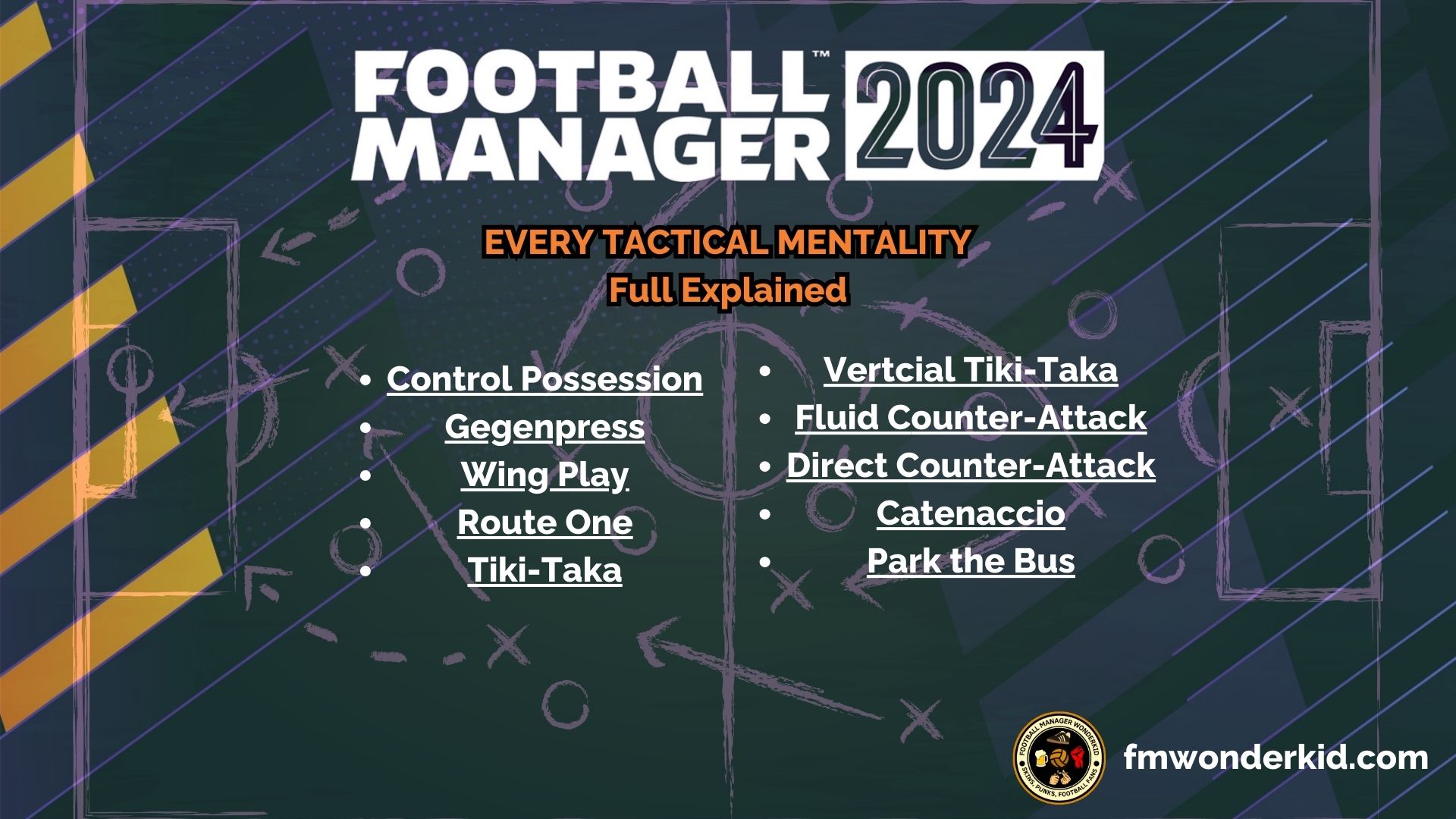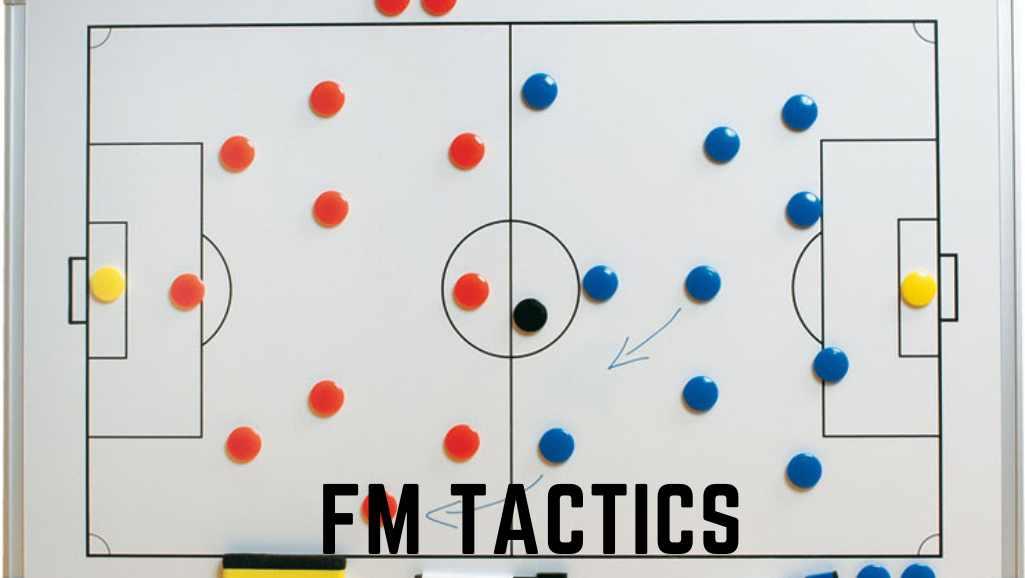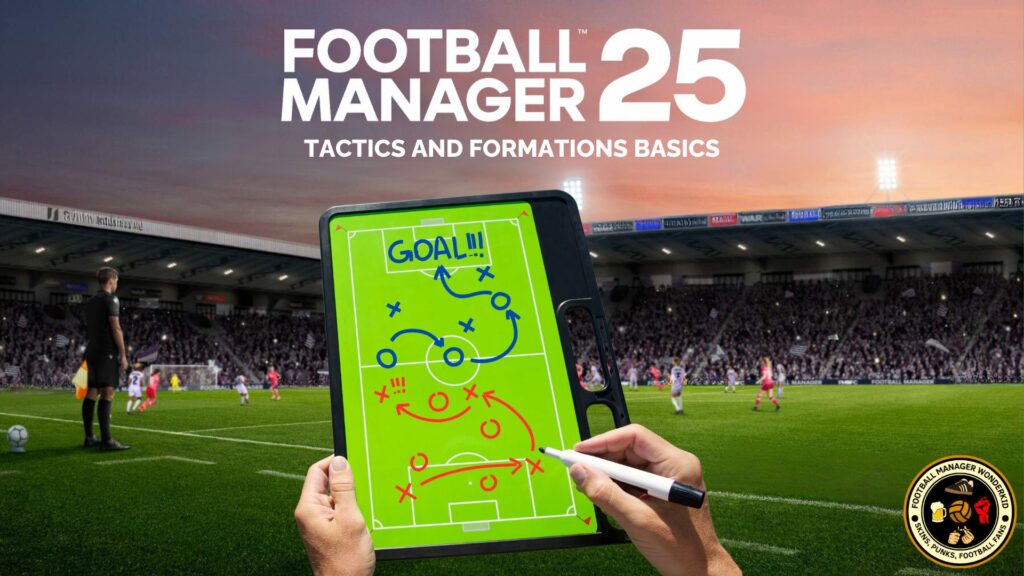Key Takeaways
- Each tactical style has an optimal mentality setting that enhances its effectiveness.
- Your choice of mentality affects every aspect of play, from defensive positioning to attacking movement.
- Successful tactics require alignment between mentality, formation, and player roles.
- Different tactical styles can achieve success with varying levels of defensive and attacking focus.
- Player attributes and team strength should influence your tactical mentality choice.
- The most effective tactics balance risk and reward based on your team’s capabilities.
FM24 Tactical Mentality Basics
The tactical mentality in Football Manager serves as the foundation of your team’s approach to matches. It determines how aggressively your players position themselves, their risk-taking in possession, and their overall decision-making on the pitch.
Think of mentality as your team’s psychological framework – it influences everything from how quickly they try to move the ball forward to how aggressively they press the opposition.
In FM24, mentality options range from Very Defensive to Very Attacking, with each setting creating distinct behavioral patterns in your team. A defensive mentality naturally positions your team deeper and encourages safer passing, while an attacking mentality pushes players forward and promotes more adventurous play.
Football Manager 2024 Tactical Styles Usage
Click for more below ↓↓↓
Let’s go to a comprehensive overview of all 10 tactical styles and mentalities
1. Tactical Style: Control Possession
This tactic is centered on ball retention and patient buildup play, prioritizing short-passing sequences to break down opponents. The team looks to play out from the back, avoiding long, direct passes. The emphasis is on structured, methodical attacking rather than quick transitions.
Control Possession Mentality: Balanced
A balanced mentality means the team will adjust its approach depending on the match situation. It is neither too aggressive nor too defensive, allowing flexibility to react to different in-game scenarios.
In Possession (Attacking Playstyle)
- Shorter Passing → Players focus on quick, short-range passes to maintain control and prevent risky turnovers.
- Play Out of Defense → The team builds attacks from the back rather than relying on long clearances.
- Work Ball Into Box → Rather than taking speculative shots, the team patiently waits for high-quality chances before attempting to score.
- Slightly Lower Tempo → A measured, deliberate pace ensures the team doesn’t rush forward, reducing the risk of losing possession.
In Transition (Switching Phases of Play)
- Take Short Kicks → The goalkeeper avoids long goal kicks, instead distributing the ball carefully to maintain possession.
- Distribute to Centre-Backs → The goalkeeper plays passes to the central defenders, reinforcing the buildup strategy.
- Counter-Press → After losing possession, players immediately try to win the ball back rather than dropping deep.
Out of Possession (Defensive Shape & Pressing)
- Higher Defensive Line → The team pushes up the field, reducing space for the opposition and allowing for effective pressing.
- Mid Block → Defenders and midfielders compactly press in the middle third, balancing defensive solidity and attacking potential.
- More Often Pressing → Players actively press opponents to win the ball back quickly.
- Prevent Short GK Distribution → Forwards and midfielders work to disrupt the opposing goalkeeper’s attempts to pass out from the back.
Recommended Formations
This tactical style is most effective with structured formations that provide width and midfield control:
- 4-2-3-1 DM AM Wide
- 4-3-3 DM Wide
- 5-2-3 DM Wide
Expert Summary of Control Possession Tactic Mentality
The Control Possession tactic in FM24 is ideal for teams looking to dominate possession, patiently create chances, and apply structured defensive pressure. The Balanced mentality ensures adaptability, while a high defensive line, counter-pressing, and short-passing approach create a cohesive playing style.
2. Tactical Style: Gegenpress
Gegenpressing (counter-pressing) is an intense, high-energy strategy focusing on winning the ball back immediately after losing possession. It requires high levels of fitness, teamwork, and mobility to maintain relentless pressure on the opposition.
Gegenpress Mentality: Positive
A Positive mentality means the team plays aggressively with an attacking focus, but not recklessly. Players push forward dynamically while maintaining a defensive structure when needed.
In Possession (Attacking Playstyle)
- Pass Into Space → Rather than always playing to feet, players look for through balls and penetrating passes behind the defense.
- Play Out of Defense → The team starts attacks from the back, avoiding long clearances unless necessary.
- Higher Tempo → A fast-paced passing game ensures quick ball circulation, overwhelming the opposition’s defensive shape.
In Transition (Switching Phases of Play)
- Take Short Kicks → The goalkeeper opts for short passes instead of long goal kicks to retain possession.
- Distribute to Centre-Backs → Ensures that the ball is played out carefully from deep areas.
- Counter-Press → The team immediately presses to regain possession when the ball is lost, preventing counter-attacks.
- Counter → When the ball is won, players immediately surge forward to exploit gaps in the opposition’s defense.
Out of Possession (Defensive Shape & Pressing)
- Higher Defensive Line → The backline pushes high up the pitch, compressing space for the opponent.
- High Press → The entire team applies intense pressure on opposition defenders to force mistakes.
- More Often Pressing → Players work relentlessly to regain the ball, ensuring constant pressure.
- Prevent Short GK Distribution → The team aggressively closes down goalkeepers to stop short build-up play.
- Step Up More → Defenders push up aggressively to catch attackers offside and keep the opposition pinned in their half.
Recommended Formations
Gegenpress works best with formations that emphasize pressing and width, allowing for effective ball recovery and transition play:
- 4-3-3 DM Wide
- 4-2-3-1 DM AM Wide
- 4-2-4 DM Wide
Expert Summary of Gegenpress Tactic Mentality
The Gegenpress tactic in FM24 is an aggressive, high-tempo system focused on pressing, quick transitions, and rapid attacking play. The Positive mentality ensures that the team remains on the front foot, while high pressing, a high defensive line, and intense ball recovery create a suffocating style that disrupts opponents and leads to quick goal-scoring opportunities.
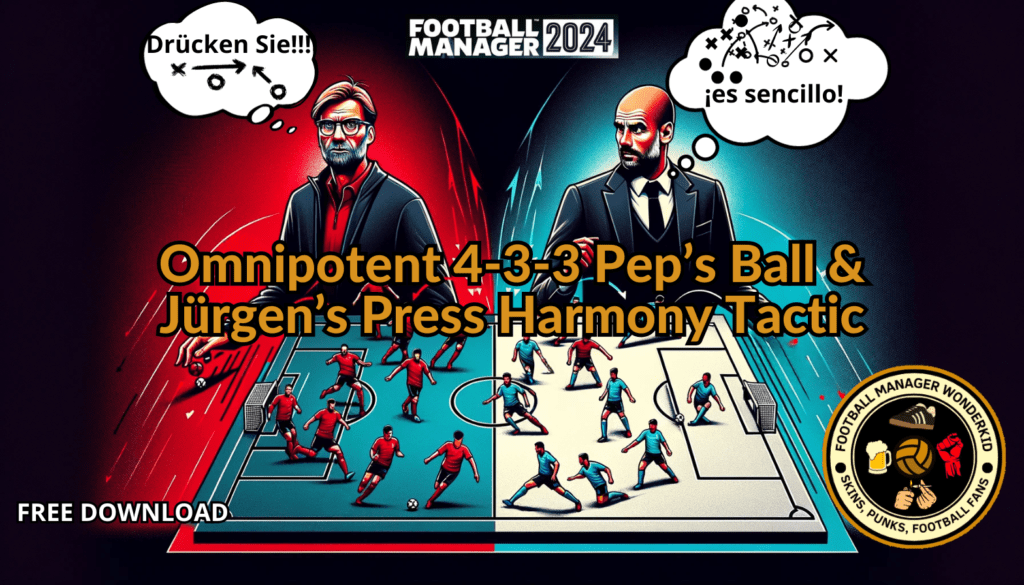
3. Tactical Style: Tiki-Taka
Tiki-Taka is a possession-based system that emphasizes short passing, constant movement, and positional play. It relies on quick, intricate passing sequences to wear down the opposition and create openings through sustained pressure. It is an extreme version of the Control Possession style, requiring technically gifted players with high composure and intelligence.
Tiki-Taka Mentality: Positive
A Positive mentality ensures the team remains proactive in attack while maintaining a structured and calculated approach to possession. Players prioritize ball retention but will look to break defensive lines when opportunities arise.
In Possession (Attacking Playstyle)
- Much Shorter Passing → Players engage in quick, short passes to retain possession and progress up the pitch.
- Play Out of Defense → Build-up starts from the backline, avoiding rushed clearances or long balls.
- Low Crosses → Instead of lofted deliveries, low-driven crosses are preferred to exploit quick passing combinations inside the box.
- Dribble Less → The focus is on team play and passing, minimizing individual dribbling runs.
- Work Ball Into Box → Attacks are methodically constructed, avoiding speculative long shots in favor of intricate build-up.
- Lower Tempo → Slower, deliberate ball movement to control the game and patiently find openings.
- Fairly Narrow → The team stays compact, encouraging short passing triangles and quick interchanges.
In Transition (Switching Phases of Play)
- Distribute to Centre-Backs → Goalkeepers initiate build-up by passing to defenders.
- Distribute Quickly → Rapid ball circulation to prevent opposition from settling into a defensive shape.
- Hold Shape → Players maintain positional discipline rather than immediately launching counter-attacks.
- Counter-Press → When possession is lost, the team presses immediately to win the ball back before the opponent can counter.
Out of Possession (Defensive Shape & Pressing)
- Much Higher Defensive Line → The team compresses the field, reducing space for the opposition.
- Mid Block → Pressing starts from midfield rather than all-out high pressing.
- Much More Often Pressing → The team constantly applies pressure to disrupt opponents’ build-up.
- Prevent Short GK Distribution → The team aggressively closes down opposition goalkeepers to force long clearances.
Recommended Formations
Tiki-Taka thrives in formations that promote fluid movement, technical interplay, and passing triangles:
- 4-3-3 DM Wide
- 4-2-3-1 DM AM Wide
- 5-2-3 DM Wide
Expert Summary of Tiki-Taka Tactic Mentality
Tiki-Taka in FM24 is a meticulous, possession-heavy strategy focused on maintaining control, short passing, and intelligent movement. The Positive mentality ensures a measured yet attacking approach, with players constantly shifting positions to create overloads and passing options. Defensively, the team applies relentless pressure, forcing mistakes and keeping opponents under sustained pressure.
Click for more below ↓↓↓
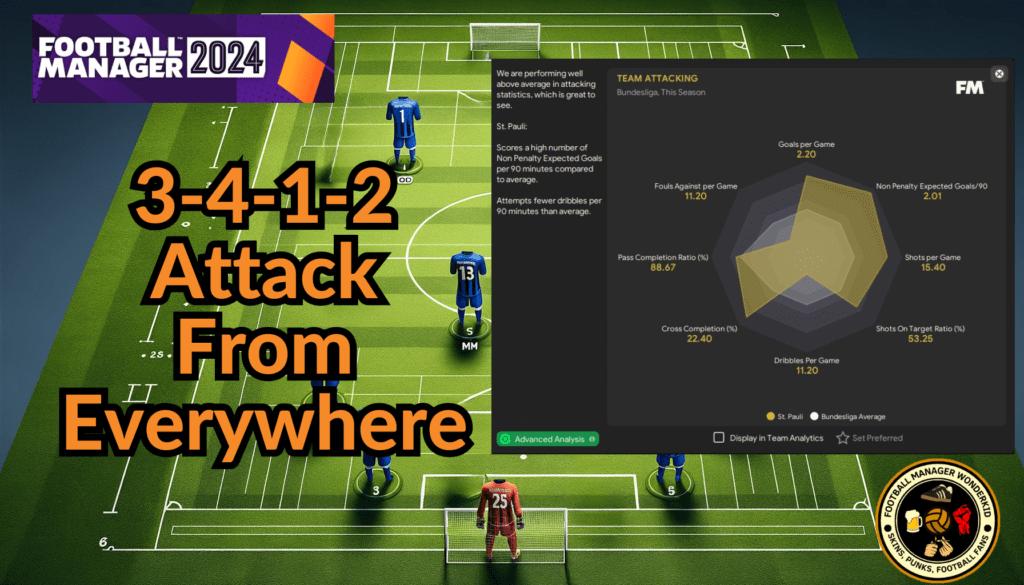
4. Tactical Style: Vertical Tiki-Taka
Vertical Tiki-Taka is a possession-based system emphasizing quick, short passing, and constant movement, but with a narrower and more direct approach than traditional Tiki-Taka. It focuses on progressing the ball vertically through the center more quickly, while still maintaining a foundation of intricate passing sequences. It’s a faster, more penetrative version of Tiki-Taka, designed to break down defenses with incisive through balls and quick combinations.
Vertical Tiki-Taka Mentality: Balanced
A Balanced mentality ensures the team maintains a structured approach to both attack and defense. While prioritizing possession and quick transitions, the team doesn’t commit fully to attack, allowing for a solid defensive foundation and a measured approach to risk-taking.
In Possession (Attacking Playstyle)
- Shorter Passing: Players engage in quick, short passes to retain possession and progress up the pitch.
- Play Out of Defense: Build-up starts from the backline, avoiding rushed clearances or long balls.
- Work Ball Into Box: Attacks are methodically constructed, favoring intricate build-up and clear-cut chances over speculative shots.
- Be More Expressive: Encourages creative passing and movement from players, allowing for improvisation within the structured system.
- Focus Play Through The Middle: Directs play through the central areas of the pitch, utilizing the strength of the midfield.
- Underlap Left/Right: Full-backs move inside to support attacks, creating overloads and offering passing options in central areas.
- Slightly Lower Tempo: While still emphasizing quick passing, the tempo is slightly reduced compared to outright “high tempo” styles, allowing for more control and patience in build-up.
- Narrow: The team stays compact, encouraging short passing triangles and quick interchanges through central channels.
In Transition (Switching Phases of Play)
- Distribute to Centre-Backs: Goalkeepers initiate build-up by passing to defenders.
- Take Short Kicks: Maintains the possession-based approach even during set-piece situations.
- Counter-Press: When possession is lost in attacking areas, the team presses immediately to win the ball back high up the pitch.
- Counter: The team looks to transition quickly into attacking moves after regaining possession, exploiting any disorganization in the opponent’s defense.
Out of Possession (Defensive Shape & Pressing)
- Higher Defensive Line: The team compresses the field, reducing space for the opposition in their own half.
- High Press: The team uses an aggressive pressing style to disrupt the opponent’s build-up and force turnovers.
- More Often Pressing: Indicates a higher frequency of pressing actions, reflecting the team’s commitment to winning the ball back quickly.
- Prevent Short GK Distribution: The team instructs defenders to avoid passing back to the goalkeeper under pressure, likely to prevent risky situations and potential turnovers near goal.
Recommended Formations
Vertical Tiki-Taka thrives in formations that promote fluid movement, technical interplay, and passing triangles, but with a focus on central progression:
- 4-3-3 DM Wide
- 4-4-2 Diamond Narrow
- 4-2-3-1 DM AM Wide
Expert Summary of Vertical Tiki-Taka Tactic Mentality:
Vertical Tiki-Taka in FM24 is a possession-heavy strategy focused on maintaining control, quick, incisive short passing, and intelligent movement, with a greater emphasis on verticality and faster transitions than traditional Tiki-Taka. The Balanced mentality ensures a measured yet proactive approach, with players constantly shifting positions to create overloads and passing options in central areas. Defensively, the team applies relentless pressure, forcing mistakes and keeping opponents under sustained pressure in their own half.
Click for more below ↓↓↓
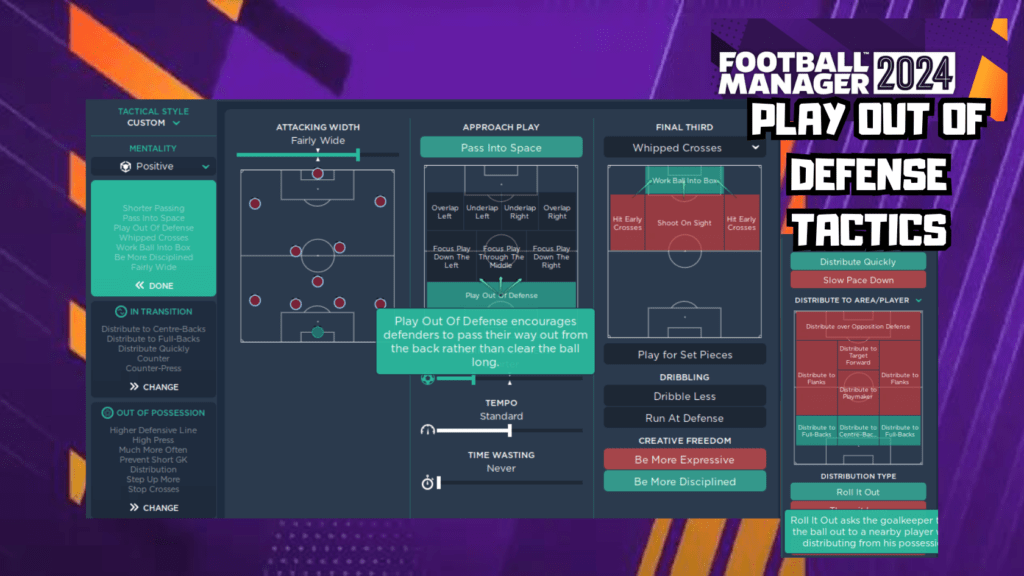
5. Tactical Style: Wing Play
Wing Play is a system that emphasizes getting the ball wide early and utilizing the flanks for attacking opportunities. It focuses on quick transitions to the wings, crosses into the box, and exploiting space created by overlapping full-backs. This style relies on pacey wingers, creative midfielders capable of accurate long passes, and forwards comfortable in the box.
Wing-Play Mentality: Balanced
A Balanced mentality ensures the team maintains a structured approach to both attack and defense. While prioritizing width and quick transitions to the flanks, the team doesn’t fully neglect defensive duties, allowing for a degree of solidity and measured risk-taking.
In Possession (Attacking Playstyle)
- Slightly More Direct Passing: Players utilize a slightly more direct passing approach to transition the ball to the wings quickly and efficiently.
- Pass Into Space: The team looks to exploit space in wide areas by passing the ball ahead of the wingers and full-backs, encouraging them to run onto through balls.
- Focus Play Down The Left/Right: Directs play towards both flanks, utilizing the width of the pitch and maximizing attacking opportunities in wide areas.
- Overlap Left/Right: Full-backs are instructed to overlap the wingers, providing support in attack and creating overloads in wide positions.
- Slightly Higher Tempo: A slightly higher tempo facilitates quick transitions and rapid ball movement to the wings.
- Wide: The team stretches play across the full width of the pitch, maximizing space for wingers to operate and crosses to be delivered.
In Transition (Switching Phases of Play)
- Distribute to Flanks: The goalkeeper and defenders are instructed to distribute the ball to the flanks, initiating quick transitions and utilizing the width of the pitch.
- Counter: The team looks to transition quickly into attacking moves after regaining possession, exploiting any disorganization in the opponent’s defense and utilizing the pace of the wingers.
Out of Possession (Defensive Shape & Pressing)
- Mid Block: Pressing starts in the midfield, aiming to disrupt the opponent’s build-up and prevent them from progressing the ball into attacking areas.
- More Often Pressing: The team applies pressure frequently to disrupt opponents’ play and force turnovers, although not as aggressively as a “high press.”
Recommended Formations
Wing Play thrives in formations that provide width, attacking full-backs, and support for crosses:
- 4-4-2
- 4-3-3 DM Wide
- 5-2-3 DM Wide
Expert Summary of Wing-Play Tactic Mentality:
Wing Play in FM24 is a strategy focused on utilizing the flanks for quick transitions and attacking opportunities. The Balanced mentality ensures a structured approach to both attack and defense, prioritizing width and crosses while maintaining a degree of defensive solidity. The team aims to get the ball to the wings quickly, where overlapping full-backs and pacey wingers look to create chances through crosses and cut-backs. Defensively, a mid-block and frequent pressing aim to disrupt the opponent’s build-up and prevent them from effectively utilizing the central areas of the pitch.
Click for more below ↓↓↓

6. Tactical Style: Route One
Route One is a direct, uncomplicated style focused on quickly progressing the ball forward and creating scoring opportunities as early as possible. It emphasizes long passes, early crosses, and exploiting set-pieces. This style relies on target forwards, midfielders capable of accurate long passing, and players with strong aerial ability.
Route-One Mentality: Balanced
A Balanced mentality ensures the team maintains a degree of defensive stability while still prioritizing the direct, attacking approach. It suggests a controlled aggression, where the team isn’t recklessly attacking at all times, but seizes opportunities for direct play when they arise.
In Possession (Attacking Playstyle)
- Much More Direct Passing: Players prioritize long, forward passes aimed at quickly reaching the opponent’s penalty area.
- Hit Early Crosses: Crosses are delivered into the box as soon as possible, often from deep positions, aiming to catch the defense unprepared.
- Play for Set Pieces: The team looks to create situations that may lead to set-piece opportunities, recognizing their potential for scoring goals.
- Be More Disciplined: This instruction likely refers to maintaining defensive shape and structure, even when adopting a direct attacking style.
- Slightly Higher Tempo: A slightly higher tempo facilitates quick transitions and rapid ball movement up the pitch.
- Waste Time Sometimes: This instruction suggests a pragmatic approach, where the team might look to slow down play strategically in certain situations to manage the game.
In Transition (Switching Phases of Play)
- Take Long Kicks: The goalkeeper and defenders prioritize long kicks to quickly move the ball forward.
- Distribute to Target Forward: Distribution is aimed at the designated target forward, who acts as a focal point for the attack.
- Regroup: After an attack breaks down, the team prioritizes regrouping and regaining defensive structure, rather than immediately pressing high.
Out of Possession (Defensive Shape & Pressing)
- Lower Defensive Line: The team adopts a deeper defensive line, likely to protect against long balls over the top and to provide more space for the defense to deal with aerial threats.
- Mid Block: Pressing starts in the midfield, aiming to disrupt the opponent’s build-up and prevent them from progressing the ball into attacking areas.
- Get Stuck In: This instruction encourages players to be more aggressive in challenges and to close down opponents quickly.
Recommended Formations
Route One can be effective in formations that provide a target forward, support for long passes, and defensive solidity:
- 4-4-2
- 4-3-3 DM Wide
- 5-3-2 DM WB
Expert Summary of Route-One Tactic Mentality:
Route One in FM24 is a direct and pragmatic strategy focused on quickly moving the ball forward and creating scoring opportunities through long passes, early crosses, and set-pieces. The Balanced mentality ensures a degree of defensive stability while still prioritizing the direct attacking approach. The team aims to exploit the aerial ability of the target forward and capitalize on any defensive disorganization. Defensively, a lower defensive line and mid-block aim to protect against direct attacks and long balls.
Click for more below ↓↓↓
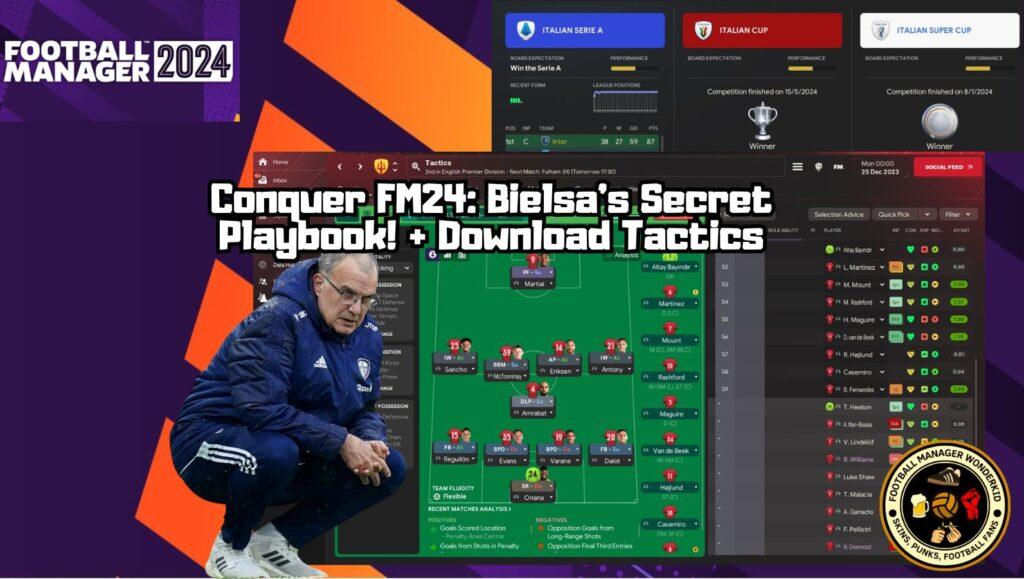
7. Tactical Style: Fluid Counter-Attack
Fluid Counter-Attack is a strategy designed to lure opponents forward, creating space to exploit on the break. It emphasizes quick transitions, fluid movement, and attacking with speed and intent. This style relies on pacey forwards, creative midfielders capable of accurate through balls, and a solid defensive foundation.
Fluid Counter-Attack Mentality: Cautious
A Cautious mentality indicates a defensive-minded approach, prioritizing solidity and minimizing risk. The team primarily focuses on defending and waiting for opportunities to counter-attack, rather than proactively seeking to dominate possession or initiate attacks.
In Possession (Attacking Playstyle)
- Shorter Passing: Players primarily utilize shorter passes to retain possession and build a solid foundation for counter-attacks, rather than risking long, hopeful balls.
- Run At Defense: This instruction encourages players to carry the ball forward when opportunities arise, driving at the defense and looking to create chances through individual skill and dribbling.
- Slightly Higher Tempo: A slightly higher tempo facilitates quick transitions and rapid ball movement when counter-attacking opportunities arise.
In Transition (Switching Phases of Play)
- Distribute Quickly: The team aims to distribute the ball quickly after regaining possession, launching swift counter-attacks before the opponent can reorganize defensively.
- Counter: The team prioritizes counter-attacking, exploiting any disorganization or vulnerability in the opponent’s defense after turnovers.
- Counter-Press: The team implements a counter-press immediately after losing possession in attacking areas, aiming to win the ball back quickly and potentially create immediate scoring opportunities.
Out of Possession (Defensive Shape & Pressing)
- Lower Defensive Line: The team employs a deep defensive line, inviting the opponent to push forward and creating space behind them to exploit on the counter-attack.
- Mid Block: Pressing starts in the midfield, aiming to disrupt the opponent’s build-up and prevent them from progressing the ball into advanced positions.
- More Often Pressing: The team applies pressure frequently to force turnovers and create opportunities for counter-attacks.
- Get Stuck In: This instruction encourages players to be more aggressive in challenges and to close down opponents quickly.
- Drop Off More: The team instructs players to drop off and protect the defensive line, further emphasizing a cautious and defensively oriented approach.
Recommended Formations
Fluid Counter-Attack can be effective in formations that provide defensive solidity, support for quick transitions, and attacking outlets:
- 4-3-3 DM Wide
- 4-2-3-1 DM AM Wide
- 5-3-2 DM WB
Expert Summary of Fluid Counter-Attack Tactic Mentality:
Fluid Counter-Attack in FM24 is a defensive-minded strategy focused on absorbing pressure and launching quick, fluid counter-attacks. The Cautious mentality reinforces a patient and disciplined approach, prioritizing defensive stability and waiting for opportunities to exploit the opponent’s attacking intent. The team aims to lure opponents forward, then quickly transition the ball to pacey forwards and creative midfielders, creating scoring chances through swift and incisive attacking moves. Defensively, a deep defensive line, mid-block, and frequent pressing aim to disrupt the opponent’s build-up and protect against sustained pressure.
Click for more below ↓↓↓
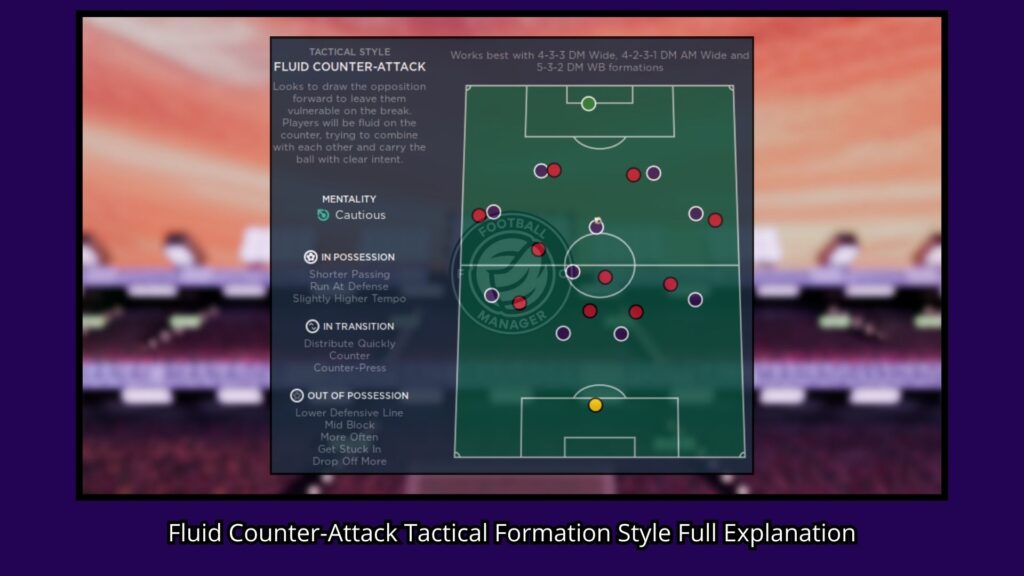
8. Tactical Style: Direct Counter-Attack
Direct Counter-Attack is a strategy built upon drawing the opposition forward and exploiting the space left behind with quick, direct attacks. It emphasizes rapid transitions, long passes, and capitalizing on set-piece opportunities. This style relies on pacey forwards, midfielders with good long-passing ability, and a well-organized defense.
Direct Counter Attack Mentality: Cautious
A Cautious mentality indicates a defensive-minded approach, prioritizing solidity and minimizing risk. The team focuses on defending and waiting for opportunities to launch quick, direct counter-attacks, rather than proactively seeking to dominate possession or initiate attacks.
In Possession (Attacking Playstyle)
- More Direct Passing: Players prioritize long, forward passes aimed at quickly reaching the opponent’s penalty area.
- Play for Set Pieces: The team looks to create situations that may lead to set-piece opportunities, recognizing their potential for scoring goals.
- Slightly Higher Tempo: A slightly higher tempo facilitates quick transitions and rapid ball movement up the pitch.
In Transition (Switching Phases of Play)
- Distribute Quickly: The team aims to distribute the ball quickly after regaining possession, launching swift counter-attacks before the opponent can reorganize defensively.
- Counter: The team prioritizes counter-attacking, exploiting any disorganization or vulnerability in the opponent’s defense after turnovers.
Out of Possession (Defensive Shape & Pressing)
- Low Block: The team defends in a compact low block, aiming to restrict space in their own half and force the opponent to try and break them down.
- Lower Defensive Line: The team employs a deep defensive line, inviting the opponent to push forward and creating space behind them to exploit on the counter-attack.
- More Often Pressing: The team applies pressure frequently to force turnovers and create opportunities for counter-attacks.
- Get Stuck In: This instruction encourages players to be more aggressive in challenges and to close down opponents quickly.
- Drop Off More: The team instructs players to drop off and protect the defensive line, further emphasizing a cautious and defensively oriented approach.
Recommended Formations
Direct Counter-Attack can be effective in formations that provide defensive solidity, support for quick transitions, and attacking outlets:
- 4-4-2
- 4-3-3 DM Wide
- 5-2-3 DM Wide
Expert Summary of Direct Counter-Attack Tactic Mentality:
Direct Counter-Attack in FM24 is a defensive-minded strategy focused on absorbing pressure and launching quick, direct counter-attacks. The Cautious mentality reinforces a patient and disciplined approach, prioritizing defensive stability and waiting for opportunities to exploit the opponent’s attacking intent. The team aims to lure opponents forward, then quickly transition the ball to pacey forwards, creating scoring chances through swift and incisive attacking moves. Defensively, a low block, deep defensive line, and frequent pressing aim to disrupt the opponent’s build-up and protect against sustained pressure.
9. Tactical Style: Catenaccio
Catenaccio is a highly defensive, tactical system primarily focused on denying the opposition goal-scoring opportunities. It emphasizes a strong, organized defense, often utilizing a libero (sweeper) to provide additional cover behind the defensive line. This style prioritizes defensive solidity above all else, aiming to frustrate opponents and capitalize on rare counter-attacking chances or set-piece opportunities.
Catenaccio Mentality: Defensive
A Defensive mentality emphasizes caution and prioritizes preventing goals over scoring them. The team focuses on maintaining a solid defensive shape, minimizing risks, and limiting the opponent’s attacking opportunities.
In Possession (Attacking Playstyle)
- More Direct Passing: While the primary focus is defense, the team utilizes more direct passing when in possession to try and quickly transition the ball into attacking areas, albeit infrequently.
- Play for Set Pieces: Recognizing the limited opportunities for open play attacks, the team focuses on maximizing set-piece situations, viewing them as prime scoring chances.
- Be More Disciplined: This instruction emphasizes strict adherence to the tactical plan and positional discipline, crucial for maintaining the highly structured defensive setup.
- Slightly Lower Tempo: A slightly lower tempo reflects the cautious approach, prioritizing control and minimizing risk in possession.
- Frequently Waste Time: This instruction highlights the pragmatic and cynical nature of Catenaccio, where time-wasting is employed strategically to disrupt the flow of the game and frustrate opponents.
- Fairly Narrow: A fairly narrow shape helps to compact the defense and limit space for the opposition to play through centrally.
In Transition (Switching Phases of Play)
- Slow Pace Down: Upon regaining possession, the team aims to slow the tempo down, prioritizing control and denying the opposition opportunities for quick counter-attacks.
- Counter: While primarily focused on defense, the team will look to counter-attack when opportunities arise, albeit with a focus on efficiency and exploiting any defensive vulnerabilities.
- Regroup: After an attack breaks down, the team immediately prioritizes regrouping and regaining their defensive shape.
Out of Possession (Defensive Shape & Pressing)
- Lower Defensive Line: The team employs a deep defensive line to maximize protection against through balls and limit space for the opposition to operate in.
- Low Block: The team defends in a compact low block, creating a formidable barrier designed to frustrate and stifle the opposition’s attack.
- Less Often Pressing: Reflecting the overall defensive philosophy, the team presses less often, primarily focusing on maintaining their defensive shape and denying space.
Recommended Formations
Catenaccio is typically associated with formations that emphasize defensive solidity and provide cover for the back line:
- 5-2-3 DM Wide
- 5-2-1-2 DM AM
- 5-2-2-1 DM AM
Expert Summary of Catenaccio Tactic Mentality:
Catenaccio in FM24 is an ultra-defensive strategy designed to prioritize preventing goals above all else. The Defensive mentality reinforces a cautious and disciplined approach, focusing on maintaining a compact defensive shape, frustrating opponents, and capitalizing on rare counter-attacking opportunities or set-piece chances. The team aims to stifle the opposition’s attack, limiting them to few clear-cut chances. While opportunities in possession are limited, the team looks to maximize set-pieces and utilize direct passing to launch quick counters when the opponent over-commits. Defensively, a deep defensive line, low block, and minimal pressing aim to create an impenetrable barrier.
Click for more below ↓↓↓
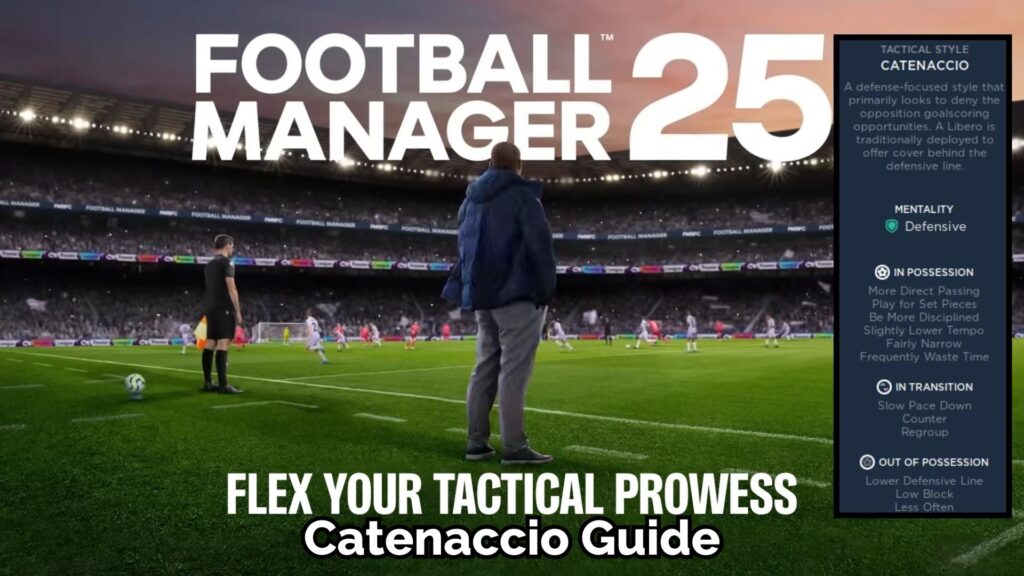
10. Tactical Style: Park the Bus
Park the Bus is an extremely defensive strategy focused on protecting the team’s defensive third and preventing goals above all else. It prioritizes defensive solidity and organization, aiming to frustrate opponents and secure a shutout. This style minimizes attacking risks and focuses on denying space and opportunities to the opposition.
Park the BUS Mentality: Defensive
A Defensive mentality emphasizes caution and prioritizes preventing goals over scoring them. The team focuses on maintaining a solid defensive shape, minimizing risks, and limiting the opponent’s attacking opportunities.
In Possession (Attacking Playstyle)
- Pass Into Space: When the team does gain possession, they look to utilize space in behind the opposition’s defense with forward passes, though these will be infrequent.
- Hit Early Crosses: If the team manages to get into attacking positions, early crosses are preferred to try and create quick scoring opportunities.
- Play for Set Pieces: Recognizing the limited opportunities for open play attacks, the team focuses on maximizing set-piece situations, viewing them as prime scoring chances.
- Be More Disciplined: This instruction emphasizes strict adherence to the tactical plan and positional discipline, crucial for maintaining the highly structured defensive setup.
- Slightly Lower Tempo: A slightly lower tempo reflects the cautious approach, prioritizing control and minimizing risk in possession.
- Waste Time Whenever Possible: This instruction highlights the pragmatic and cynical nature of Park the Bus, where time-wasting is employed strategically to disrupt the flow of the game and frustrate opponents.
In Transition (Switching Phases of Play)
- Take Long Kicks: The goalkeeper and defenders prioritize long kicks to quickly move the ball forward, bypassing the midfield and aiming to relieve pressure on the defense.
- Slow Pace Down: Upon regaining possession, the team aims to slow the tempo down, prioritizing control and denying the opposition opportunities for quick counter-attacks.
- Regroup: After an attack breaks down, the team immediately prioritizes regrouping and regaining their defensive shape.
Out of Possession (Defensive Shape & Pressing)
- Lower Defensive Line: The team employs a deep defensive line, positioned right on the edge of their defensive third, creating a compact barrier designed to prevent through balls and limit space for the opposition to operate in.
- Low Block: The team defends in a compact low block, positioned deep in their own half, creating a formidable barrier designed to frustrate and stifle the opposition’s attack.
- Less Often Pressing: Reflecting the extremely defensive philosophy, the team presses very little, primarily focusing on maintaining their defensive shape and denying space.
- Get Stuck In: While the team doesn’t press high, this instruction encourages players to be committed in their challenges and to close down opponents quickly when they do engage.
- Drop Off More: The team instructs players to drop off and protect the defensive line, further emphasizing a cautious and defensively oriented approach.
- Trap Outside: This instruction aims to force the opposition wide, where they are less likely to be dangerous, and to prevent them from playing through the center of the defense.
Recommended Formations
Park the Bus is typically associated with formations that emphasize defensive solidity and provide cover for the back line:
- 4-4-2
- 4-2-4 DM Wide
- 4-3-3 DM Wide
Expert Summary of Park the Bus Tactic Mentality:
Park the Bus in FM24 is an ultra-defensive strategy designed to prioritize preventing goals above all else. The Defensive mentality reinforces a cautious and disciplined approach, focusing on maintaining an extremely compact defensive shape, frustrating opponents, and minimizing any attacking risks. The team aims to stifle the opposition’s attack, limiting them to few clear-cut chances. Possession is largely sacrificed in favor of defensive solidity, and the team looks to maximize set-pieces and utilize direct passing to launch quick counters when the opponent over-commits. Defensively, an extremely deep defensive line, low block, and minimal pressing aim to create an impenetrable barrier.
Frequently Asked Questions
Q: How do I know which tactical style best suits my team?
A: Consider your players’ attributes, their preferred roles, and your team’s overall technical ability. Match these factors with the requirements of each tactical style.
Q: Can I mix elements from different tactical styles?
A: Yes, but ensure the combinations make logical sense and don’t create conflicts in player instructions or team mentality.
Q: How important is player fitness for different tactical styles?
A: Styles like Gegenpress and Tiki-Taka demand high fitness levels, while more defensive approaches like Catenaccio and Park the Bus are less physically demanding.
Q: Should I adjust my tactical style based on opposition strength?
A: Yes, considering opposition quality is crucial. You might want to adopt a more defensive approach against stronger teams and a more attacking style against weaker opponents.
Q: How do tactical styles affect player development?
A: Players tend to develop attributes that align with their tactical roles, so consider long-term development when choosing a tactical style.

